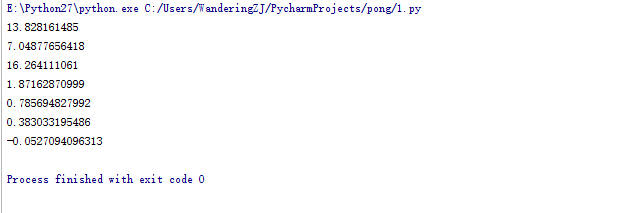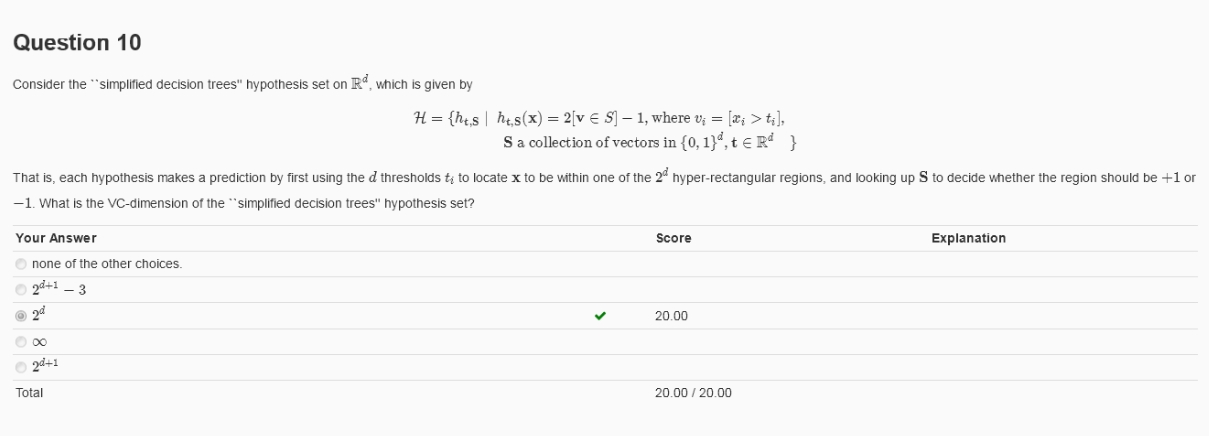
出现noisy时错误的可能性,这题是简单的概率问题,μ是h出错的概率,当y=f(x)时出错:λμ;当otherwise时出错:(1-λ)(1-μ)。
=> λμ+(1-λ)(1-μ)

h的表现和μ无关,λμ+(1-λ)(1-μ)=1-λ-(1-2λ)μ => λ=0.5

根据公式4(2N)dVC exp(-1/8 ξ2 N)=0.05求得sample size最接近的是460000

1 import matplotlib.pyplot as plt 2 import numpy as np 3 4 t = np.arange(-10,10,0.01) 5 6 def original_vc_bound(n): 7 return np.sqrt(((8.0 / n) * (np.log(80) + 50 * np.log(2 * n)))) 8 9 def rademacher_penalty_bound(n): 10 return 1.0 / n + np.sqrt((2.0 / n) * np.log(20)) + np.sqrt((2.0 * (np.log(2 * n) + 50 * np.log(n))) / n) 11 12 def parrondo_vandenBroek(t, n): 13 return t - np.sqrt(1.0 / n * (2 * t + np.log(120) + 50 * np.log(2 * n))) 14 15 def devroye(t, n): 16 return t - np.sqrt(1.0 / (2 * n) * (4 * t * (1 + t) + np.log(80) + 100 * np.log(n))) 17 18 def variant_VC_bound(n): 19 return np.sqrt(16.0 / n * (np.log(2 / np.sqrt(0.05)) + 50 * np.log(n))) 20 21 print original_vc_bound(10000) 22 print rademacher_penalty_bound(10000) 23 print variant_VC_bound(10000) 24 25 plt.subplot(211) 26 plt.plot(t,parrondo_vandenBroek(t, 10000)) 27 plt.subplot(212) 28 plt.plot(t, devroye(t, 10000)) 29 plt.show() 30 31 print parrondo_vandenBroek(0.331308785962, 10000) 32 print devroye(0.331308785962, 10000) 33 34 print parrondo_vandenBroek(0.22, 10000) 35 print devroye(0.22, 10000)


parrondo_vandenBroek在图上可以看到大概当x = 0.22时,y < 0
devroye在图书可以看到大概当x = 0.22时,y > 0,x的bound肯定小于0.22
综上Devroye bound smallest
1 import matplotlib.pyplot as plt 2 import numpy as np 3 4 t = np.arange(-10,10,0.01) 5 6 def original_vc_bound(n): 7 return np.sqrt(((8.0 / n) * (np.log(80) + 50 * np.log(2 * n)))) 8 9 def rademacher_penalty_bound(n): 10 return 1.0 / n + np.sqrt((2.0 / n) * np.log(20)) + np.sqrt((2.0 * (np.log(2 * n) + 50 * np.log(n))) / n) 11 12 def parrondo_vandenBroek(t, n): 13 return t - np.sqrt(1.0 / n * (2 * t + np.log(120) + 50 * np.log(2 * n))) 14 15 def devroye(t, n): 16 return t - np.sqrt(1.0 / (2 * n) * (4 * t * (1 + t) + np.log(80) + 100 * np.log(n))) 17 18 def variant_VC_bound(n): 19 return np.sqrt(16.0 / n * (np.log(2 / np.sqrt(0.05)) + 50 * np.log(n))) 20 21 print original_vc_bound(5) 22 print rademacher_penalty_bound(5) 23 print variant_VC_bound(5) 24 25 plt.subplot(211) 26 plt.plot(t,parrondo_vandenBroek(t, 5)) 27 plt.subplot(212) 28 plt.plot(t, devroye(t, 5)) 29 plt.show() 30 31 print parrondo_vandenBroek(7.04877656418, 5) 32 print devroye(7.04877656418, 5) 33 34 print parrondo_vandenBroek(5.5, 5) 35 print devroye(5.5, 5)


很明显,最tightest的是
parrondo_vandenBroek

此题就是将N个数,拆成positive和negtive,最多只能三部分,排列组合:
C(n-1,2)*2 + C(n-1,1)*2 +2 = n2-n+2

由于已经有了mh(N)所以直接计算break point,n=3时m=8,n=4时m=14 => k=4 => dvc=3

可以把此题看成点在以a为半径的圆和以b为半径的圆之间时为1,其余情况-1
可将所有情况分为2种,N个点全不在a,b之间和其他
=> 在n个点的n+1个空间里选2个+n个点之外的任意空间 => C(n+1,2)+1

degree is D,hypothesis parameters c = (c0;c1;····;cd );
=> dVC = D + 1

把[xi > ti]看成一个d维度的决策树,那么可以选出这样2d个点使得[xi > ti]后,得到决策树的2d个叶子节点v。可以选择
不同的S,使得2d个叶子节点v,得到所有2^2d个结果。即N=2d时可以shatter,N=2d+1时,[xi > ti]后最多只能得到
2d个叶子节点,所有必定有一个重复,所以不管使用什么S,都无法得到2^(2d+1)个结果,即N=2d+1时不可shatter,综上
N=2d+1是break point => dvc =2d

感觉上由于α是随便取的,每个点都有机会取到两种情况所以2n,不知道该如何证明。。。。

这题很明显,等于是求每个函数的复杂度,√N^dvc是O(N^(dvc/2));mh(n/2)是O((n/2)^dvc);2dvc;
2i*mh(n-i)由于指数的存在肯定是大于mh(n)所以至少是O(N^(dvc));
由于N ≥ dvc ≥ 2 => O(N^(dvc)) > O(N^(dvc/2)),O((n/2)^dvc),2dvc
=> 2i*mh(n-i) upper

很明显N是不对的,如果存在成长函数mh(n)=n,那么它的break point就在n=1的时候,那么如果当n=2
时,mh(2)=2,那么其中至少有一个点存在2种情况 => 该点shatter =>矛盾
此时mh(n)=1

intersection,肯定是越交集越小,依题意最小肯定是0,最大肯定也是小于H1~Hk里最小的

union,肯定是越并越大,所以最小也得H1~Hk里最大的,关于为什么不是0老师给了很好的解答
(any single hypothesis is of VC dimension 0,but the union of many hypotheses (which is a hypothesis set) can be of non-zero VC dimension)
upper bound比较麻烦,思考了很久,在论坛里看老师和小伙伴的回帖,有了些启发。我们思考这样一种情况Hk
dvc为n,总共有2n+k-1-(k-1)中情况也就是缺k-1种情况shatter,而这k-1种情况分别是single hypothesis H1~HK-1,
很明显unionH1~Hk的dvc是n+k-1 = sum(dvc)+k-1
并且:不考虑dvc max的H,每个H的情况2dvc_hi ≤ hi ≤ 2dvc_hi+ti < 2dvc_hi+1
因为x>1时,2x1*2x2 > 2x1+2x2 => union(hi) ≤ sum(2dvc_hi+ti) ≤ ∏(2dvc_hi+1)
=> dvc(union(hi)) ≤ dvc(∏(2dvc_hi+1)) = sum(dvc(hi)+1)
=>加上max 后dvc(∏(2dvc_hi+1)) = sum(dvc(hi))+k-1

当Θ>0时:
当s==1:Eout=((1-Θ)*s*0.2+(1-(1-Θ)*s)*0.8+1*0.2)/2=0.5+0.3*(Θ-1)*s
当s==-1:Eout=(-(1-Θ)*s*0.8+(1+(1-Θ)*s)*0.2+1*0.8)/2=0.5+0.3*(Θ-1)*s
由于Θ<0时和Θ>0时是对称的,综上
=> Eout=0.5+0.3*(|Θ|-1)*s

x = [i / 10.0 for i in range(-10, 11)] x.remove(0) y = [] error = 0 best = 100 for i in x: if i <= 0: y.append(-1) else: y.append(1) y[0] = 1 y[9] = 1 y[19] = -1 y[10] = -1 for i in range(5000): if i < 2500: s = -1 else: s = 1 theta = -1 + (i % 2500) / 1250.0 for j in range(20): if x[j] > theta: t = 1 else: t = -1 if t * s * y[j] < 0: error += 1 if best > error: best = error error = 0 print best / 20.0


1 import math 2 x = [i / 10.0 for i in range(-10, 11)] 3 x.remove(0) 4 y = [] 5 error = 0 6 best = 100 7 bestTheta = 0 8 bestS = 0 9 10 for i in x: 11 if i <= 0: 12 y.append(-1) 13 else: 14 y.append(1) 15 y[0] = 1 16 y[9] = 1 17 y[19] = -1 18 y[10] = -1 19 20 for i in range(5000): 21 if i < 2500: 22 s = -1 23 else: 24 s = 1 25 theta = -1 + (i % 2500) / 1250.0 26 27 for j in range(20): 28 if x[j] > theta: 29 t = 1 30 else: 31 t = -1 32 if t * s * y[j] < 0: 33 error += 1 34 if best > error: 35 best = error 36 bestTheta = theta 37 bestS = s 38 error = 0 39 40 print 0.5 + 0.3 * (math.fabs(bestTheta) - 1) * bestS


1 import math 2 x1 = [] 3 x2 = [] 4 x3 = [] 5 x4 = [] 6 y = [] 7 file = open("C:/Users/samsung/Desktop/ntumlone_hw1_hw1_18_train.dat") 8 for line in file: 9 lines = line.split(' ') 10 x1.append(float(lines[0])) 11 x2.append(float(lines[1])) 12 x3.append(float(lines[2])) 13 x4.append(float(lines[3].split(' ')[0])) 14 y.append(int(lines[3].split(' ')[1].split(' ')[0])) 15 file.close() 16 x = [x1, x2, x3, x4] 17 error = 0 18 best = 10000 19 bestTheta = 0 20 bestS = 0 21 for t in range(4): 22 for i in range(5000): 23 if i < 2500: 24 s = -1 25 else: 26 s = 1 27 theta = 0 + (i % 2500) / 2500.0 28 29 for j in range(500): 30 if x[t][j] > theta: 31 a = 1 32 else: 33 a = -1 34 if a * s * y[j] < 0: 35 error += 1 36 if best > error: 37 best = error 38 bestTheta = theta 39 bestS = s 40 error = 0 41 42 print best / 500.0


1 import math 2 x1 = [] 3 x2 = [] 4 x3 = [] 5 x4 = [] 6 y = [] 7 file = open("C:/Users/samsung/Desktop/ntumlone_hw1_hw1_18_train.dat") 8 for line in file: 9 lines = line.split(' ') 10 x1.append(float(lines[0])) 11 x2.append(float(lines[1])) 12 x3.append(float(lines[2])) 13 x4.append(float(lines[3].split(' ')[0])) 14 y.append(int(lines[3].split(' ')[1].split(' ')[0])) 15 file.close() 16 x = [x1, x2, x3, x4] 17 error = 0 18 best = 10000 19 bestTheta = 0 20 bestS = 0 21 bestT = 0 22 for t in range(4): 23 for i in range(100000): 24 if i < 50000: 25 s = -1 26 else: 27 s = 1 28 theta = 0 + (i % 50000) / 50000.0 29 30 for j in range(500): 31 if x[t][j] > theta: 32 a = 1 33 else: 34 a = -1 35 if a * s * y[j] < 0: 36 error += 1 37 if best > error: 38 best = error 39 bestTheta = theta 40 bestS = s 41 bestT = t 42 error = 0 43 print bestT 44 print bestTheta 45 print bestS 46 print best / 500.0 47 48 file = open("C:/Users/samsung/Desktop/ntumlone_hw1_hw1_18_test.dat") 49 xtest = [] 50 ytest = [] 51 for line in file: 52 lines = line.split(' ') 53 xtest.append(float(lines[3].split(' ')[0])) 54 ytest.append(int(lines[3].split(' ')[1].split(' ')[0])) 55 56 file.close() 57 for j in range(500): 58 if xtest[j] > bestTheta: 59 a = 1 60 else: 61 a = -1 62 if a * bestS * ytest[j] < 0: 63 error += 1 64 print error / 500.0

